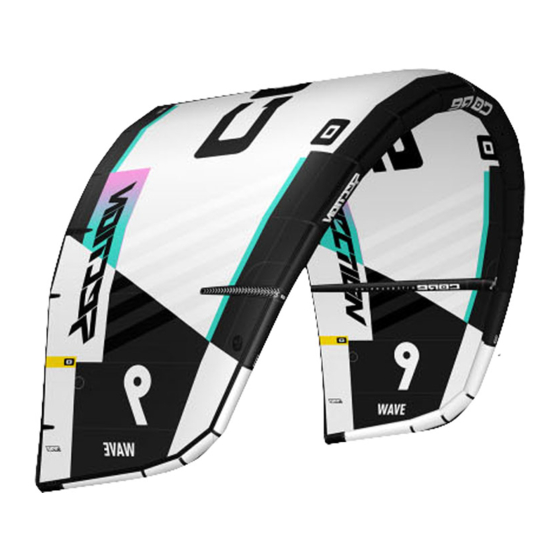Core SECTION 4 Manuel - Sayfa 8
Spor & Kamp; Açık Hava Core SECTION 4 için çevrimiçi göz atın veya pdf Manuel indirin. Core SECTION 4 12 sayfaları.

CORE INTELLIGENT TRIM SYSTEM
Each CORE kite is delivered with the optimum all-round
trim settings. You are however able to trim your CORE kite
to suit your personal preferences and requirements.
Trimming the
bar pressure & kite feedback
more backline tension
less backline tension
CIT MODES: OFFSHORE – ALLROUND – ONSHORE
We take pride in the signature bar feedback we
build into every CORE kite. The unique Section 4 CIT
(CORE Intelligent Trim) brings bar feedback
customization to a whole new level with three
settings: Offshore – Allround – Onshore. Each
setting adjusts the kite's performance to match
your preferred riding style.
The OFFSHORE setting delivers massive depower
and fast turns. Exceptional drift and responsive
flying characteristics complement its smooth
power delivery. Bar pressure goes up a notch while
steering forces remain low. This setting will raise
the game of every wave rider.
The ONSHORE setting puts the kite deeper into
the wind window. Here, the Section 4 generates a
steady pull, progressive power delivery, and wider
turns. This setting also reduces bar pressure and
slightly increases steering forces.
standard
The standard ALLROUND setting is the middle knot.
This point is a sweet combination most riders prefer
and is a great place to start.
CIT. Another innovative feature brought to you by
CORE. Experiment with every setting! And above all,
enjoy your new kite!
TRIMMING THE BAR PRESSURE, TRIMMING THE KITE
FEEDBACK
With these trim options you can determine the kite's
feedback through the bar. The standard setting is
the middle knot. This setting allows for the perfect
compromise between medium bar pressure and
good kite feedback. If you attach the bridle closer to
the middle of the kite, the bar pressure increases
slightly and the kite feedback is increased. If you
attach the bridle closer to the tip of the kite, the bar
pressure decreases and the kite feedback is slightly
reduced. This feature is unique to CORE kites.
Experiment with all the different trim options.
13
Trimming the turning speed
TRIMMING THE TURNING SPEED
You are able to change the turning speed of the
kite at the kite tip. The closer the flying lines are
attached to the kite tip, the faster your kite will
turn.
Unhooked wakestylers and beginners select
the front position for medium turning speed
(MEDIUM).
For freeriders we would recommend the middle
setting for quick turning speed (EASY).
The wave riding mode – the back position – with
the quickest turning speed is
reserved for experts (SUPER EASY).
PUMP UP YOUR KITE PROPERLY
With pressure gauge: watch the needle and
pump up your kite between 7-8 psi. With smaller
kites, with thinner leading edges (LE), err towards
8 psi whilst with a bigger kites and correspondin-
gly thicker LE err towards 7 psi.
If you don't have a gauge just follow this simple
SIZES IN M²
4
5
6
PRESSURE IN PSI
8
8
8
test: hold the (floating) kite in front of you and
flick your finger against the kite. If the kite makes
a "Pong" sound the pressure is not enough and
you'll need to pump it up a little more. If, on
the other hand, you hear a "Ping" the pressure
is perfect and you're good to go! If the "Ping"
sounds a little metallic you have pumped the kite
up too hard and you'll need to release some air
from the kite.
Be aware that inflating your kite with more or
less pressure than recommended might cause
damage to the kite.
PREFLIGHT CHECKLIST
1. Make sure your launch is open, free of down-
wind bystanders, hard objects, nearby power
lines, buildings and walls, within at least 200 ft.
(60 m), and preferably more. Some riders have
needed in excess of 500 ft. (170 m), to regain
control in violent dragging or loftings. Avoid
kiteboarding near airports and in low flight path
areas, complaints have led to restricted access
in some areas.
2. Check to see what kite size other kiteboarders
are rigging and get their input on conditions. Do
not rig too large a kite for conditions and carefully
consider advice of more experienced riders.
Failure to act on prudent advice has cost some
riders severe injury.
3. Check your kite for tears or leaky bladders.
If you have leaky bladders or tears in your kite,
repair them before flying.
7
8
9
10
11
12
13½
8
8
8
8
8
8
8
14
